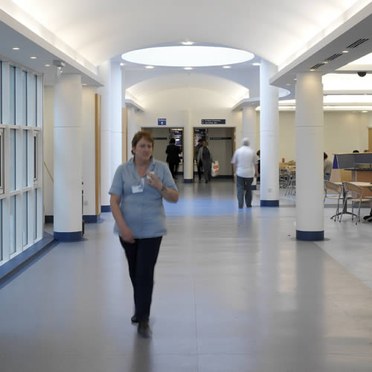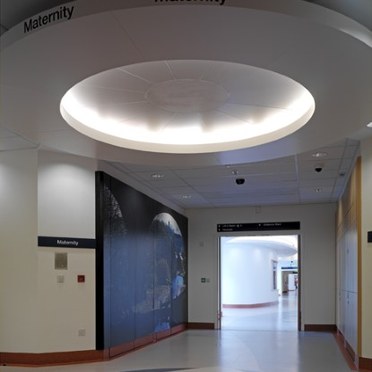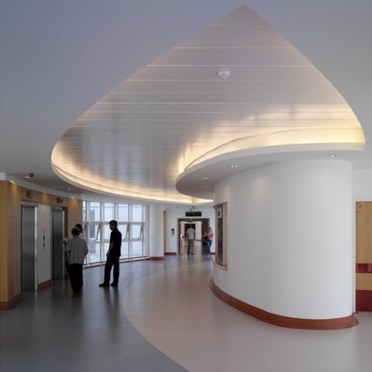Russells Hall Hospital, Dudley
- Lamp efficacy
Lamp efficacy
Ensuring the lamp efficiently converts electricity into light (lm/W).
- Ballast classification
Ballast classification
Controlling the electricity supply to the lamp (Energy Efficiency Index).
- Luminaire distribution
Luminaire distribution
Controlling light emission using optics which bend and shape the light to the correct location.
- System efficacy
System efficacy
Combining optical and thermal control within the luminaire (luminaire lm/W).
- Presence/absence detection
Presence/absence detection
Presence: Lights automatically turn on/off with movement. Absence: Lights automatically turn off and must be manually switched on.
- Daylight detection
Daylight detection
Artificial lighting which responds to the natural light conditions.
- Constant illuminance
Constant illuminance
A function designed to produce correct light levels for the duration of the maintenance period.
- Task-scene setting
Task-scene setting
Allowing the user to set scenes and adapt the lighting to different tasks.
- Timed off
Timed off
Automatic cut-off can be installed to turn all lights off during unoccupied hours.
- Task lighting
Task lighting
Lighting task areas with the correct amount of light.
- Zoning of lighting
Zoning of lighting
Lighting is zoned according to area use.
- Maintenance schedule
Maintenance schedule
Maintenance must be performed in response to product age, performance and environment.
- Waste light
Waste light
Eliminating waste light which does not hit the intended target.
- Reflectance
Reflectance
Taking advantage of light which is reflected from the surface within the space.
- Visible smart metering
Visible smart metering
Results of actions can be quickly seen as increased or decreased energy use to encourage responsible energy consumption.
Uplights down glare
Good hospital lighting is not simply a question of using stereotyped arrangements of lights and increasing lighting levels. It is matching a system to particular requirements.
An extension by part of the Dudley Group of Hospitals NHS Trust, provides an excellent example. Good hospital lighting is not simply a question of using stereotyped arrangements of lights and increasing lighting levels. It is matching a system to particular requirements. An extension by part of the Dudley Group of Hospitals NHS Trust, provides an excellent example.
The main circulation thoughfares, also known as hospital streets, experience relatively busy traffic with the constant conveyance of patients on trolleys and wheelchairs – so that a basic requirement for the lighting system was that it should be glare free and avoid centrally mounted fittings as the visual disturbance of moving under alternating high and low brightness is undesirable.
The solution was to position the luminaires to one side of the corridor and in a further refinement employ pelmet mounted lighting. Thorn Arrowslim Connect fluorescent fittings were installed which plug together to give a continuous chain of pleasing, comfortable light. Because the light is produced indirectly, by reflecting light from the ceiling, there are no problems of glare.
In the new installation attention is also paid to direction signs, emergency lighting and making sure that the far ends of the corridors are well lit. A lighting control system operates and clever window design makes excellent use of available natural daylight.
Lead contractor for the project was Sir Robert McAlpine and electrical installation was by Drake & Scull.



